Students can practice TS Class 10 Maths Solutions Chapter 6 Progressions Ex 6.2 to get the best methods of solving problems.
TS 10th Class Maths Solutions Chapter 6 Progressions Exercise 6.2
Question 1.
Fill in the blanks in the following table, given that a is the first term, d the common difference and an the nth term of the A.P :
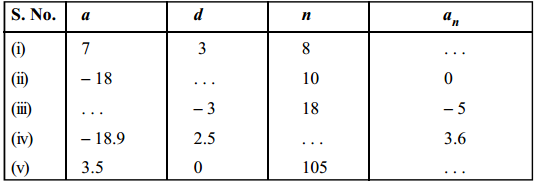
Solution:
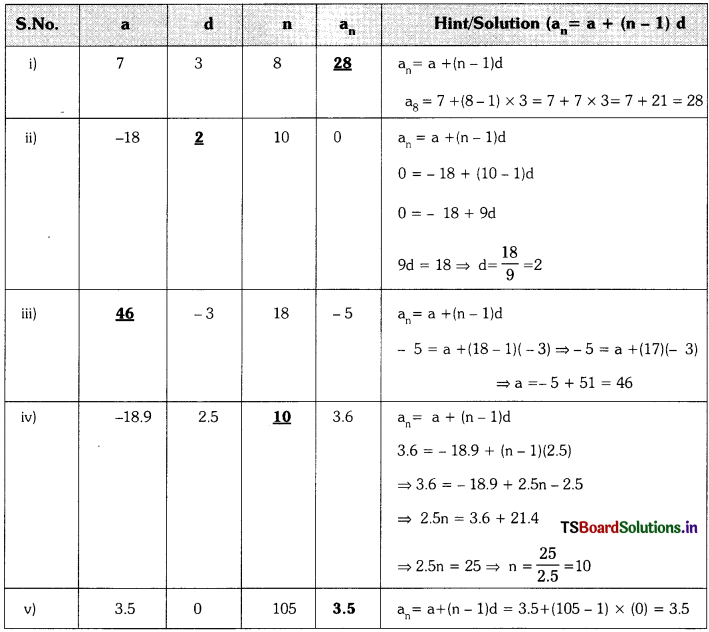
Question 2.
Find the
i) 30th term of the A.P. : 10, 7, 4, …… (A.P. June 15)
ii) 11th term of the A.P. : -3, \(\frac{-1}{2}\) ,2, …….
Solution:
i) Given A.P. = 10, 7, 4, ….
a1 = 10; d = a2 – a1 = 7 – 10 = – 3
an = a + (n – 1) d
a30 = 10 + (30 – 1)(-3)
= 10 + 29 × (- 3)
= 10 – 87
= -77
ii) Given A.P. = -3, \(\frac{-1}{2}\), 2,……..
a1 = -3; d = a2 – a1 = \(\frac{-1}{2}\) – (-3)
= \(\frac{-1}{2}\) + 3 = = \(\frac{-1+6}{2}\) = \(\frac{5}{2}\)
an = a + (n – 1)d
a11 = -3 + (11 – 1) × (\(\frac{5}{2}\))
= -3 + 10 × \(\frac{5}{2}\)
= -3 + 5 × 5
= -3 + 25 = 22
![]()
Question 3.
Find the respective terms for the following APs.
i) a1 = 2; a3 = 26, find a2.
Solution:
Given : a1 = a = 2 —— (1)
a3 = a + 2d = 26 —— (2)
Equation (2) – equation (1)
⇒ (a + 2d) – a = 26 – 2
⇒ 2d = 24
d = \(\frac{24}{2}\) = 12
Now a2 = a + d = 2 + 12 = 14
ii) a2 = 13; a4 = 3, find a1, a3.
Solution:
Given : a2 = a + d = 13 —— (1)
a4 = a + 3d = 3 —- (2)
Solving equations (1) and (2);
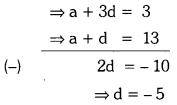
Substituting, d = – 5 in equation (1) we get
a + (-5) = 13
∴ a = 13 + 5 = 18
i.e., a1 = 18
a3 = a + 2d = 18 + 2(-5)
= 18 – 10 = 8
iii) a1 = 5; a4 = 9\(\frac{1}{2}\), a2, a3.
Solution:
Given : a1 = a = 5 —– (1)
a4 = a + 3d = 9\(\frac{1}{2}\) —– (2)
Solving equations (1) and (2);
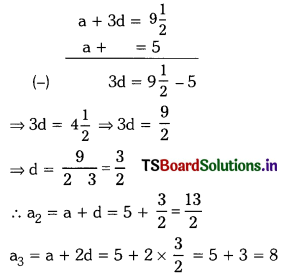
iv) a1 = – 4; a6 = 6, find a2, a3, a4, a5.
Solution:
Given : a1 = a = – 4 —– (1)
a6 = a + 5d = 6 —– (2)
Solving equations (1) and (2);
(-4) + 5d = 6 ⇒ 5d = 6 + 4
⇒ 5d = 10 ⇒ d = \(\frac{10}{5}\) = 2
Now, a2 = a + d = -4 + 2 = -2;
a3 = a + 2d = -4 + 2 × 2
= -4 + 4 = 0;
a4 = a + 3d = (-4) + 3 × 2
= -4 + 6 = 2;
a5 = a + 4d = -4 + 4 × 2
= -4 + 8 = 4
v) a2 = 38; a6 = -22, find a1, a3, a4, a5.
Solution:
Given : a2 = a + d = 38 —– (1)
a6 = a + 5d = -22 —– (2)
Subtracting (2) from (1) we get
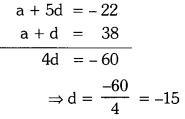
Now substituting, d = -15 in equation (1), we get
a + (-15) = 38 ⇒ a = 38 + 15 = 53 Thus,
a1 = a = 53;
a3 = a + 2d = 53 + 2 × (-15) = 53 – 30 = 23;
a4 = a + 3d = 53 + 3 × (-15) = 53 – 45 = 8;
a5 = a + 4d = 53 + 4 × (-15) = 53 – 60 = -7
![]()
Question 4.
Which term of the AP :
3, 8, 13, 18, ……. is 78 ?
Solution:
Given : 3, 8, 13, 18,
Here a = 3; d = a2 – a1 = 8 – 3 = 5
Let ’78’ be the nth term of the given A.P.
∴ an = a + (n – 1) d
78 = 3 + (n – 1)5
78 = 3 + 5n – 5
⇒ 5n = 78 + 2 ⇒ n = \(\frac{80}{5}\) = 16
∴ 78 is the 16th term of the given A.P.
Question 5.
Find the number of terms in each of the following APs :
i) 7, 13, 19, ……., 205 (A.P. Mar. ’16)
Solution:
Given : A.P : 7, 13, 19, ………
Here a1 = a = 7; d = a2 – a1 = 13 – 7 = 6
Let 205 be the nth term of the given A.P.
Then, an= a + (n – 1) d
205 = 7 + (n – 1) 6
⇒ 205 = 7 + 6n – 6
⇒ 205 = 6n + 1
⇒ 6n = 205 – 1 = 204
∴ n = \(\frac{204}{6}\) = 34
∴ 34 terms are there.
ii) 18, 15\(\frac{1}{2}\), 13, ………, -47.
Solution:
Given A.P = 18, 15\(\frac{1}{2}\), 13, ….
Here a1 = a = 18
d = a2 – a1 = 15\(\frac{1}{2}\) – 18 = -2\(\frac{1}{2}\) = –\(\frac{5}{2}\)
Let ‘-47’ be the nth term of the given A.P.
an = a + (n – 1) × d
⇒ -47 = \(\frac{18 \times 2+(n-1)(-5)}{2}\)
⇒ – 94 = 36 – 5n + 5
⇒ 5n = 94 + 41 ⇒ n = \(\frac{135}{5}\) = 27
i.e., 27 terms are there.
Question 6.
Check whether, -150 is a term of the AP : 11, 8, 5, 2, ….
Solution:
Given A.P. = 11, 8, 5, 2,
Here a = a2 – a1 = 8 – 11 = -3
If possible, take -150 as the n,sup>th term of the given A.P.
an = a + (n – 1) d
-150 = 11 + (n – 1) × (- 3)
⇒ -150 = 11 – 3n + 3
⇒ 14 – 3n = -150
⇒ 3n = 14 + 150 = 164
∴ n = \(\frac{164}{3}\) = 54\(\frac{2}{3}\)
Here n is not an integer.
∴ -150 is not a term of the given A.P.
Question 7.
Find the 31st term of an A.P. whose 11th term is 38 and the 16th term is 73.
Solution:
Given : An A.P. whose
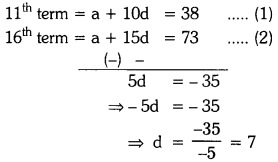
Substituting d = 7 in the equation (1) we get,
a + 10 × 7 = 38
⇒ a + 70 = 38
⇒ a = 38 – 70 = – 32
Now, the 31st term = a + 30d
= (- 32) + 30 × 7
= – 32 + 210 = 178
Question 8.
If the 3rd and the 9th terms of an A.P are 4 and – 8 respectively, which term of this A.P is zero ?
Solution:
Given : An A.P whose
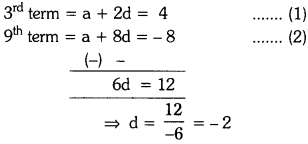
Substituting d = – 2 in equation (1) we get a + 2 × (- 2) = 4
⇒ a – 4 = 4
⇒ a = 4 + 4 = 8
Let nth term of the given A.P be equal to zero.
an = a + (n – 1) d
⇒ 0 = 8 + (n – 1) × (-2)
⇒ 0 = 8 – 2n + 2
⇒ 10 – 2n = 0
⇒ 2n = 10 and n = \(\frac{10}{2}\) = 5
∴ The 5th term of the given A.P is zero.
Question 9.
The 17th term of an A.P exceeds its 10th term by 7. Find the common difference.
Solution:
Given an A.P. in which a17 = a10 + 7
⇒ a17 – a10 = 7
We know that an = a + (n – 1) d
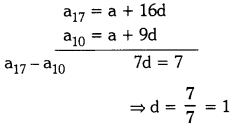
Question 10.
Two APs have the same common difference. The difference between their 100th terms is 100, what is the difference between their 1000th terms ?
Solution:
Let the first A.P be : a, a + d, a + 2d,
Second A.P be : b, b + d, b + 2d, b + 3d,….
Also, general term, an = a + (n – 1) d
Given that, a100 – b100 = 100
⇒ a + 99d – (b + 99d) = 100
⇒ a – b = 100
Now the difference between their 1000 terms,

∴ The difference between their 1000th terms is (a – b) = 100.
Note : If the common difference for any two A.Ps are equal then difference nth terms of two A.Ps is same for all natural values of n.
![]()
Question 11.
How many three-digit numbers are divisible by 7 ?
Solution:
The list of three digit numbers divisible by 7 , is,
105, 112, 119, ………, 994
Here a = 105; d = 7; an = 994
an = a + (n – 1) d
994 = 105 + (n – 1) 7
(n – 1)7 = 889
n -1 = \(\frac{889}{7}\)
n – 1 = 127
∴ n = 127 + 1 = 128
There are 128 three digit numbers which are divisible by 7.
Question 12.
How many multiples of 4 lie between 10 and 250 ?
Solution:
Given numbers : 10 to 250
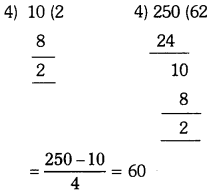
∴ Multiples of 4 between 10 and 250 are
First term : 10 + (4 – 2) = 12
Last term : 250 – 2 = 248
∴ 12, 16, 20, 24, ………, 248
a = a1 = 12; d = 4: an = 248
an = a + (n – 1) d
248 = 12 + (n – 1) × 4
⇒ (n – 1) 4 = 248 – 12
⇒ n – 1 = \(\frac{236}{4}\) = 59
∴ n = 59 + 1 = 60
There are 60 numbers between 10 and 250 which are divisible by 4.
Question 13.
For what value of n, are the nth terms of two APs : 63, 65, 67, … and 3, 10, 17, …. equal ?
Solution:
Given : The first A.P is 63, 65, 67, ….
where a = 63, d = a2 – a1
⇒ d = 65 – 63 = 2
and the second A.P is 3, 10, 17, ….
where a = 3, d = a2 – a1 = 10 – 3 = 7
Suppose the nth terms of the two A.Ps are equal, where an = a + (n – 1) d
⇒ 63 + (n -1) 2 = 3 + (n – 1) 7
⇒ 63 + 2n – 2 = 3 + 7n – 7
⇒ 61 + 2n = 7n – 4
⇒ 7n – 2n = 61 +4
⇒ 5n = 65
⇒ n = \(\frac{65}{5}\) = 13
∴ 13th terms of the two A.Ps are equal.
Question 14.
Determine the AP whose third term is 16 and the 7th term exceeds the 5th term by 12.
Solution:
Given : An A.P in which
a3 = a + 2d = 16 —– (1)
and a7 = a5 + 12
i.e., a + 6d = a + 4d + 12
⇒ 6d – 4d = 12
⇒ 2d = 12
⇒ d = \(\frac{12}{2}\) = 6
Substituting d = 6 in equation (1) we get
a + 2 × 6 = 16
⇒ a = 16 – 12 = 4
∴ The series/A. P is a, a + d, a + 2d, a + 3d, …
⇒ 4, 4 + 6, 4 + 12, 4 + 18, …
⇒ A.P: 4, 10, 16, 22,….
Question 15.
Find the 20th term from the end of the AP : 3, 8, 13,…….., 253.
Solution:
Given : An A.P : 3, 8, 13, …., 253
Here a = a1 = 3
d = a2 – a1 = 8 – 3 = 5
an = 253, where 253 is the last term
an = a + (n – 1) d
∴ 253 = 3 + (n – 1) 5
⇒ 253 = 3 + 5n – 5
⇒ 5n = 253 + 2
⇒ n = \(\frac{255}{5}\) = 51
∴ The 20th term from the other end would be
1 + (51 – 20) = 31 + 1 = 32
∴ a32 = 3 + (32 – 1) × 5
= 3 + 31 × 5
= 3 + 155
= 158
![]()
Question 16.
The sum of the 4th and 8th terms of an AP is 24 and the sum of the 6th and 10th terms is 44. Find the first three terms of the (A.P. Mar. ’15)
Solution:
Given an A.P in which
a4 + a8 = 24 ⇒ a + 3d + a + 7d = 24
⇒ 2a + 10d = 24
⇒ a + 5d = 12 —– (1)
and a6 + a10 = 44
⇒ a + 5d + a + 9d = 44
⇒ 2a + 14d = 44
⇒ a + 7d = 22 —– (2)
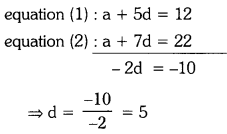
Also a + 5d = 12
⇒ a + 5(5) = 12
⇒ a + 25 = 12
⇒ a = 12 – 25 = -13
∴ The A.P is a , a + d, a + 2d, ……..
i.e., – 13, (- 13 + 5), (- 13 + 2 × 5)
⇒ -13, -8, -3, ………
Question 17.
Subba Rao started work in 1995 at an annual salary of ₹ 5,000 and received an increment of ₹ 200 each year. In which year did his income reach Rs. 7000?
Solution:
Given : Salary of Subba Rao in 1995 = ₹ 5000
Annual increment = ₹ 200
i.e., His salary increases by Rs. 200 every year.

Clearly 5000, 5200, 5400, ……… forms an A.P in which a = 5000 and d = 200.
Now suppose that his salary reached ₹ 7000
after x – years,
i.e., an = 7000
But, an = a + (n – 1) d
7000 = 5000 + (n – 1) 200
⇒ 7000 – 5000 = (n – 1) 200
⇒ n – 1 = \(\frac{2000}{200}\)
= 10
⇒ n = 10 + 1 = 11
∴ In 11th year his salary reached ₹ 7000.